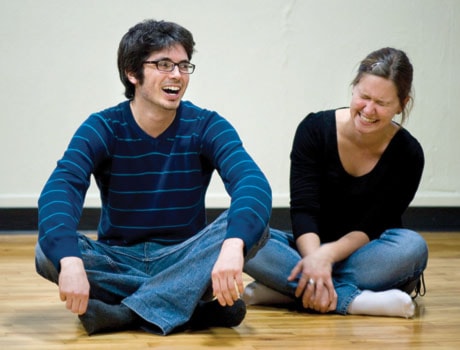What if you really could laugh your problems away?
It’s no joke: proponents of laughter therapy believe a daily dose of hearty giggles and belly laughs can help one relax, feel better and reduce stress levels.
Although the idea has been around since the 1970s, laughter therapy has gained more steam in recent years.
Now, seminars are increasingly common in hospital and workplace settings and, in a sign of its mainstream appeal, laughter therapy has been featured on The Oprah Winfrey Show.
In Canada, the business of laughter is booming. Every province has certified laughter leaders.
And the therapy is being used everywhere: with cancer patients; in the workplace to try to foster a stress-free environment; and even in the treatment of alcohol and drug addiction.
Laughter has been shown to increase endorphins, improve relaxation through the lowering of blood pressure, reduce stress and increase muscle function.
Part of the appeal of laughter therapy is that it’s easy and can be done anywhere.
“It’s ours and it’s with us every second of every day,” said Cheryl Oberg, a Calgary-based laughter specialist.
“We can share it with others, we can use it in relationship building, it’s the number one universal language around the world — everyone speaks the language of laughter.”
While some people engage in laughter exercises at home by themselves, a group setting works best as laughter is infectious.
About 20 people gather at a Montreal dance studio to take part in a weekly laughter therapy session. There are no jokes being traded or comedies playing on a television screen.
Instead, the participants are forcing themselves to laugh for no apparent reason, employing a rule that’s a central tenet to laughter therapy — “fake it till you make it” — because even fake laughter does the trick.
A little group giggling does the trick and the fake howls become genuine. What follows is an hour of laughter exercises as the group of adults do their best version of jolly St. Nick with gibberish giggles and howling animal laughs.
At the end of each exercise, they repeat a laugh mantra: “ho, ho, ha ha ha.” Any stress and anxiety present is gone, and the positive energy is flowing. The class ends with a few minutes of silence and the yoga component of the therapy — a focus on breathing.
“I feel relaxed, smiling,” Antoine Laforest, president of the Montreal Laughter Club, says at the end of the session.
He’s been taking part in the classes for about five years, compelled to do so after waking up one day and realizing he had forgotten how to laugh.
“I started coming to the laugh club because I wasn’t laughing anymore,” he says. “I was stressed out and I was doing art therapy when the instructor suggested this as a way of expressing myself more.”
Laughing for no reason can take a little getting used to, says one laughter leader.
“It’s very bizarre and the people at first are inhibited because they find it so ridiculous,” says John Lejderman, a Montreal laughologist who’s dabbled with laughter for some 30 years.
“But if you go back to your childhood, as a very young child you often laughed for no reason. As adults, we lose this childish innocence so it’s kind of like going back to this child-like state.”
At Heritage Home, a residential drug rehab centre located near the Quebec-U.S. border, laughter therapy is used to help addicts.
The sessions, which have been going on for a few years, are led by Montreal journalist and filmmaker Albert Nerenberg, who produced a documentary on laughter therapy and is a certified laughter leader.
“You couldn’t think of a worse potential audience therapy than a group of miserable, angry addicts just off drugs, in the worst moods possible,” Nerenberg said.
“You had people who were very hard cases ... but the change was amazing based on the simple principle that laughter can take bad moods and turn them into good moods.”
Heritage Home director Catherine Cosgrove said using laughter to treat addiction was an obvious choice. Therapy can be very heavy and people need a release.
“Therapy can be a pretty sombre affair, so I was looking for (laughter therapy) to counterbalance some of that,” Cosgrove said. For the 30 or so clients who tried the therapy, the results were encouraging.
Giggling for better health is becoming more accepted now.
The most famous case of laughter’s therapeutic effects came from American journalist Norman Cousins, who, in his 1979 book “Anatomy of an Illness,” claimed laughter and vitamins helped cure him of a potentially fatal illness.
Then 16 years later, Dr. Madan Kataria, an Indian physician based in Mumbai, thought of starting a laughter club after doing research on the healing benefits of laughter.
There are an estimated 6,000 laughter clubs in India and the movement has gone global.
In fact, the therapy has proven so popular that the Internet is full of promises of everything from weight loss to curing depression. But what role laughter plays in healing is up for debate.
Laughter is not a cure-all, Nerenberg cautions.
“It seems a little bit like it’s a panacea for everything and it’s not,” Nerenberg says.
“But I think it’s interesting that people have been applying laughter to so many things.”
